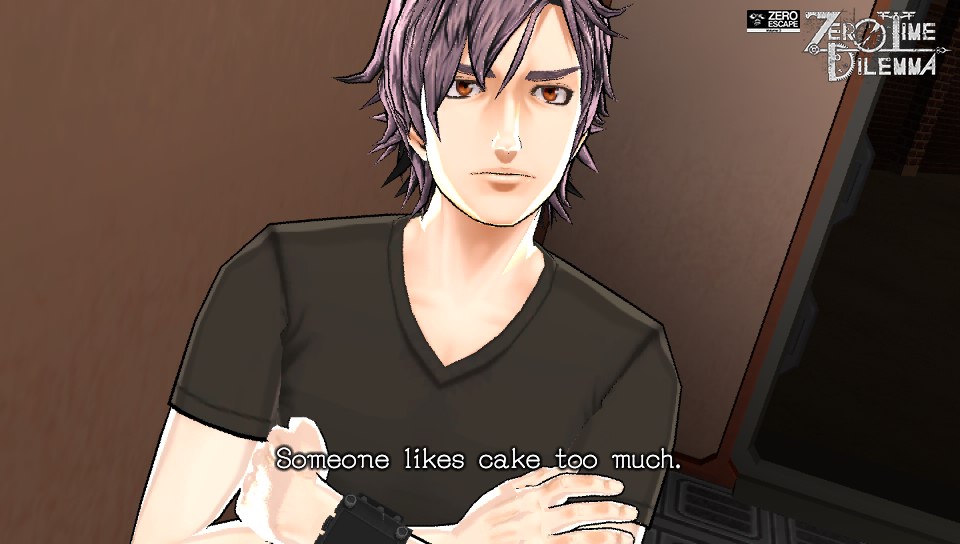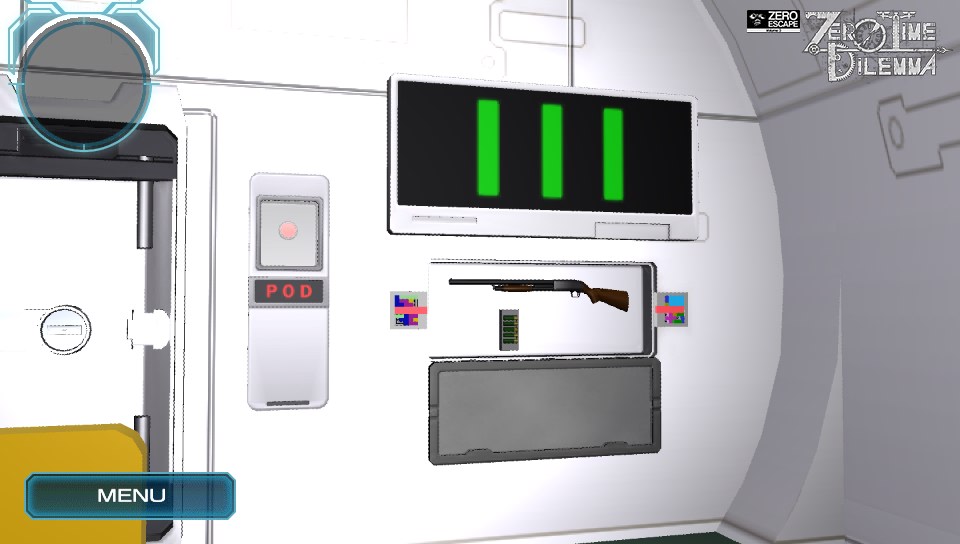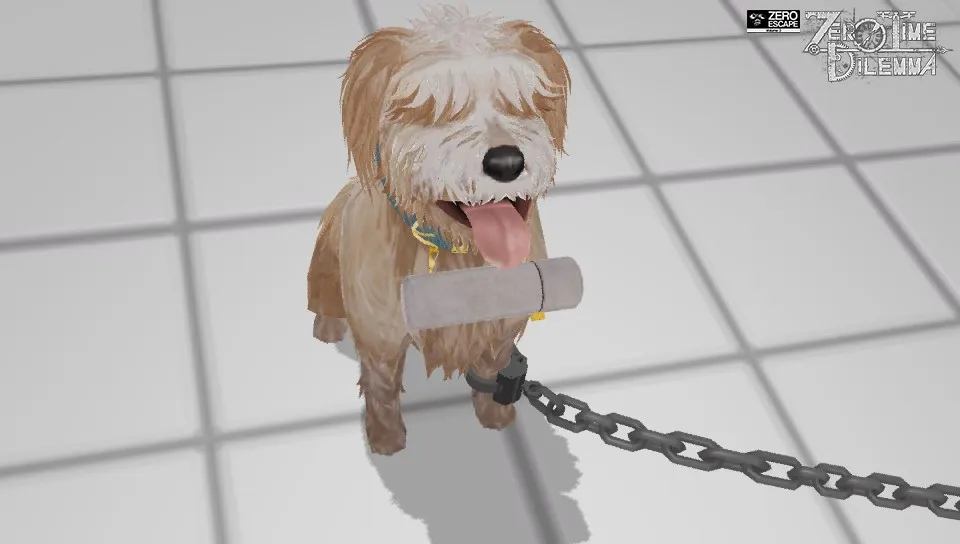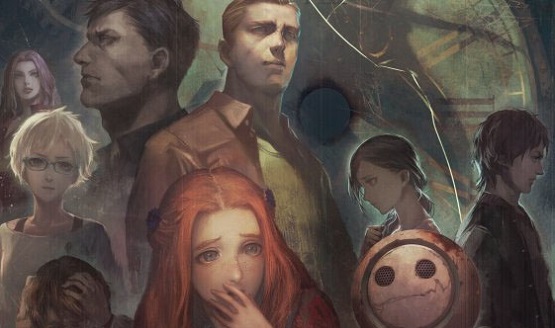Sometimes, you just can’t believe what you’re holding in your hands is real. Thanks to delays and/or problems with development, a game you’ve been anticipating can start to seem like a legend rather than a tangible product. I think many people will experience this feeling later this year, when The Last Guardian and Final Fantasy XV finally make it out of their long, arduous development cycles. For me, though, it was seeing the title screen of Zero Time Dilemma that gave me such chills. When Kotaro Uchikoshi announced the third game might never happen back in 2014, I was heartbroken. I was such a huge fan of 999: Nine Hours, Nine Persons, Nine Doors and Virtue’s Last Reward, and I just needed to know how things were going to turn out for my favorite characters. In fact, one of the first news stories I ever wrote as a game journalist was about “Operation Bluebird,” the effort to save Uchikoshi’s project. That’s why, two years later, it’s so amazing to actually have the result right in front of me: the final chapter in the Zero Escape saga is here, and it lives up to the legacy set by its predecessors while carving a path all its own.

If you’re interested to know how the game turned out but aren’t interested in having it ruined, don’t worry: I’m keeping this review spoiler-free. That includes any mention of the other games’ big plot points, too — so while you Zero Escape diehards know why this game’s narrative actually takes place between the first and second games while still technically being a sequel, I’m not going to spill the beans. Suffice it to say this: much like 999 and VLR, the story at its core is about nine people trapped in a facility and forced to play a killing game. The contestants this time include Phi, Sigma, Akane and Junpei, who have appeared in the series’ previous entries; Mira, a mysteriously cold woman; Eric, Mira’s apparent boyfriend who works at an ice cream shop; Q, a young boy with amnesia and a bizarre helmet; Carlos, a noble and clear-headed firefighter; and Diana, a soft-spoken nurse. This time around, the group is split up into the same three teams for the majority of the game’s running time, which leads to a bit of a different dynamic from previous entries.
Nothing Is What It Seems
My favorite part of the Zero Escape series is finding out that basically nothing is what it appears to be. Having played the first two games, I was lulled into a false sense of security, thinking I might have some idea of where the story was going. But Uchikoshi is a master of suspense and plot twists, and so — after a number of tantalizing mysteries piled up — I was hit with one insane revelation after another. If I’m being honest, it was hard to contain my excitement, and I found myself giving into the joy of the storytelling; more than one of the reveals caused me to shout “THAT’S SO COOL!” at the top of my lungs. There’s nothing quite like the way Uchikoshi pulls the rug out from under you and forces you to examine what you’ve seen in a new way. You realize that clues were there the whole time, and by changing your perspective on the events that have unfolded, it’s like you’re seeing what truly happened for the first time. And since the “visual novel” element of the game has been ditched in favor of cutscenes, this makes the ride all the more brisk and exhilarating: this is a 20-hour game where each minute is a little more compelling than the last. There’s no filler, so you’re never bored.

As far as gameplay goes, things follow a fairly predictable formula, much like the previous entries: you’ll first play a room escape level, in which you find clues and solve puzzles in order to “find a way out,” then move onto the “Decision Game,” where antagonist Zero forces you to make a nail-biting choice. As usual, the room escape sections are an absolute blast — and strangely enough, they can feel kind of relaxing in contrast to the tense, threatening moments of the narrative sections. From my perspective, these are some of the easier rooms and puzzles that we’ve seen across the series’ history, but I don’t think that’s a bad thing — they’re now accessible enough for newcomers while remaining challenging enough for veterans. Plus, unlike the other games, I never felt compelled to whip out a walkthrough (although I didn’t really have a choice, given that one didn’t exist yet!); I found sticking with the puzzles was satisfyingly tricky and devoid of the often-infuriatingly obtuse sections you might see in 999 and VLR.
Your Decision Is Made
As I said, once you’ve escaped each room, you’ve got to handle the truly difficult parts: the “Decision Games.” In the other Zero Escape titles, there were predictable decisions that had to be made at predictable intervals. Here, it seems like anything goes, and that keeps things immensely exciting. One moment, you’ll be playing a terrifying game of Russian roulette; the next, you’ll be running through past events in your mind, attempting to uncover the identity of a killer. But while these “Decision Games” are quite varied in unique, they do have one thing in common: horrifying, uncompromising violence. So soon after the Orlando shootings, it was a little disturbing to witness the level and frequency of blood spilling from the nine characters — and yet, I have to admit that Zero Time Dilemma handles it in a way that games with much less violence only wish they could pull off. The key is that Uchikoshi’s use of violence is never exploitative. You’re made to feel as though you’re as much of a participant as any of the other nine victims, which instills a natural sort of empathy. Whenever something horrible happens, you’re not watching with morbid fascination, you’re feeling the pain right along with them — which is why, whenever it came time to make a decision that could lead to more such violence, I felt my palms start to sweat. Making you really consider the consequences of your actions is something I really want to see more games address.

A Mixed Presentation
There’s one thing left to address, and it’s the only area where Zero Time Dilemma stumbles a bit: the presentation. To be sure, the voice acting — both English and Japanese (dual audio, yay!) — is uniformly excellent, as is Shinji Hosoe’s cold, tense score (the man knows how to make you feel anxious with just a couple of notes). The actual animation for the cutscenes, though, is… Well, it’s not good, to be perfectly honest. Odd, goofy mouth movements and robotic limbs make all the characters seem the slightest bit off, and a couple of serious moments — in which characters get knocked around — seemed unintentionally hilarious given the stilted animation. But, and this is a huge but, you get used to it enough that you’re able to immerse yourself in the situations. Yes, there’s no denying that it’s of poor quality, it’s hard to consider this a huge negative when the narrative remains completely compelling in spite of it.

A Narrative Masterpiece
Zero Time Dilemma is a masterpiece of storytelling. I could barely put the game down through its intense 20-hour running time, and when I had to — whether for work, social engagements or sleep — puzzling out the plot and the solutions to escape rooms filled my every waking moment and dozing dream. In a matter of days, I’d gotten the Platinum and seen all there was to see, but the haunting images of violence, wonderfully complex characters and heavy themes still lingered with me. Whether you’ve never experienced the Zero Escape series before or you’ve been eagerly awaiting this entry since the end of Virtue’s Last Reward, you owe it to yourself to take this ride. Both on its own and as a piece of the cumulative ZE puzzle, this easily has the best narrative I’ve seen in a game so far this year and should go down as one of the all-time greatest stories told through the medium.
Review code for Zero Time Dilemma provided by publisher. Reviewed on PlayStation Vita. For more information on scoring, please read our Review Policy here.
-
Excellent, twist-filled narrative that keeps you guessing
-
Just about every question from the series' previous entries is answered
-
As usual, the wonderful characters keep us coming back
-
Puzzle rooms are a bit more accessible this time without sacrificing their trickiness
-
Animation quality is poor








